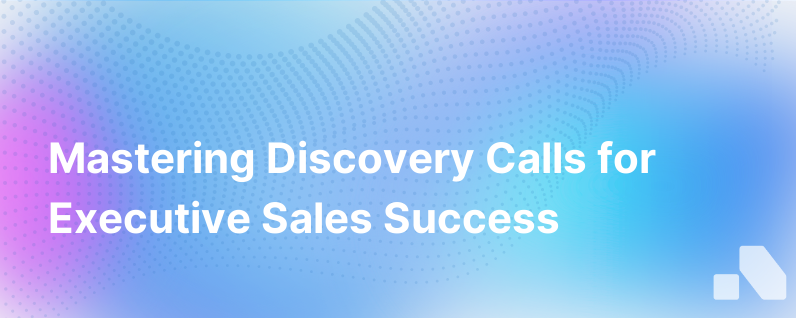
When embarking on the journey of sales, the discovery call stands as a milestone, marking the transition from prospecting to actively engaging with a potential client. A well-executed discovery call is like laying a strong foundation for a new building—it sets the stage for everything that follows, and its integrity is paramount to the success of the entire structure.
In this detailed exploration, we'll dissect the anatomy of an effective discovery call, offering a dossier of strategies and tactics that can elevate a simple conversation into a pivotal step towards a closed deal.
Decoding the Discovery Call
At its core, a discovery call is the initial interaction between a sales professional and a prospect that determines whether there is enough common ground for a business relationship to blossom. The discovery call isn't about pitching—it's an investigatory mission aimed at understanding the prospect's needs, challenges, pain points, and goals.
The Crucial Objectives of a Discovery Call
- Unearth Key Insights: The primary goal of a discovery call is to gather as much relevant information about the prospect as possible. This includes learning about their business operations, current challenges, and the potential impact your solution might have.
- Qualify the Prospect: A great discovery call helps you assess whether the prospect aligns with your ideal customer profile. This means determining if they have the authority, budget, and genuine need for what you're offering.
- Establish Rapport: Building a strong rapport creates a trusting environment where prospects feel comfortable sharing their concerns and aspirations. Your aim should be to come across as a consultant rather than a salesperson.
- Plan Next Steps: By the end of the call, you should have a clear understanding of the subsequent steps. This might involve scheduling a demo, a follow-up meeting, or drawing up a proposal.
Before the Call: Preparation is Key
"Chance favors the prepared mind," as Louis Pasteur famously said, and this couldn't be truer for discovery calls. Preparation allows you to enter the call with confidence and conveys to the prospect that you value their time and business. Here's how to prepare effectively:
- Research the Company: Utilize sources like LinkedIn, company websites, and news articles to understand the prospect's industry, company size, competitors, and recent developments.
- Understand the Prospect: Learn about the individual you'll be engaging with. Discover their role in the company, their influence on decision-making, and any professional interests or pain points.
- Prepare Your Questions: Have a list of open-ended questions ready that encourage the prospect to share detailed information. Structure them in a way that gradually builds a comprehensive picture of the prospect's situation.
- Set Clear Objectives: Know what you want to achieve by the end of the call, be it qualifying the prospect, establishing rapport, or laying the groundwork for the next stage in the sales process.
During the Call: The Art of Conversation
The discovery call dances on the fine line between structure and fluidity. While having a plan is indispensable, the ability to steer the conversation naturally is what marks the distinction between an average and an extraordinary salesperson. Focus on:
- Active Listening: This is more than just not speaking while the other person is talking. Active listening means absorbing the information, processing it, and using it to guide the conversation.
- Building trust: Establish yourself as a trustworthy advisor. This involves honesty, transparency, and displaying a genuine interest in solving the prospect's challenges.
- Mastering the Flow: Guide the conversation with your prepared questions but be ready to let the prospect lead you down paths you might not have anticipated—you never know what opportunities might be uncovered.
Sample Discovery Call Blueprint
While no two calls are the same, a general blueprint can provide a guideline for navigating the conversation:
- Introduction and Agenda Setting:
"Thank you for taking the time to speak with me today. In the next 30 minutes, I'd like to learn about your current operations, any challenges you're facing, and how we might be able to help. Does that work for you?"
- Understanding the Current Situation:
"Could you tell me more about your current process for [relevant business function]? What are some of the key objectives you're aiming to achieve?"
- Digging into Challenges:
"What are the biggest hurdles you encounter with [relevant issue or process]? How do these challenges affect your overall goals?"
- Exploring Impact and Desires:
"If you could wave a magic wand and change one aspect of [relevant process], what would it be? What impact would that have on your team?"
- Budget, Authority, Need & Timeline (BANT):
"Considering potential solutions, do you have a budget allocated, and what’s your timeline for implementing a solution? Who else in your organization would be involved in the decision-making process?"
- Next Steps and Follow-Up:
"Based on our conversation, it seems like [summarize insights]. I believe we can help with [briefly outline potential solutions]. Can we schedule a time for a more in-depth demonstration with [key stakeholders]?"
After the Call: Strategic Follow-Up
Post-call, promptly send a personalized email that recaps the key points discussed, the value your solution could potentially add, and outlines the agreed-upon next steps. This email not only serves as a reference document but also demonstrates your diligence and commitment to addressing the prospect's needs. Ensure that you also update your CRM with new insights gained from the call.
Crafting the Discovery Call Into an Art Form
In conclusion, the discovery call is an art form where the artist—the salesperson—must wield the brush with both intention and adaptability, creating a masterpiece that is both informed by strategy and inspired by genuine engagement. It's here that the seeds of trust are sown, from which a lucrative relationship may blossom.
As a part of the strategic sales process, Aomni supports high-performing teams by providing AI-powered insights that can enrich discovery calls with relevant, real-time data, ensuring that you're always a step ahead in the game of strategic B2B sales.